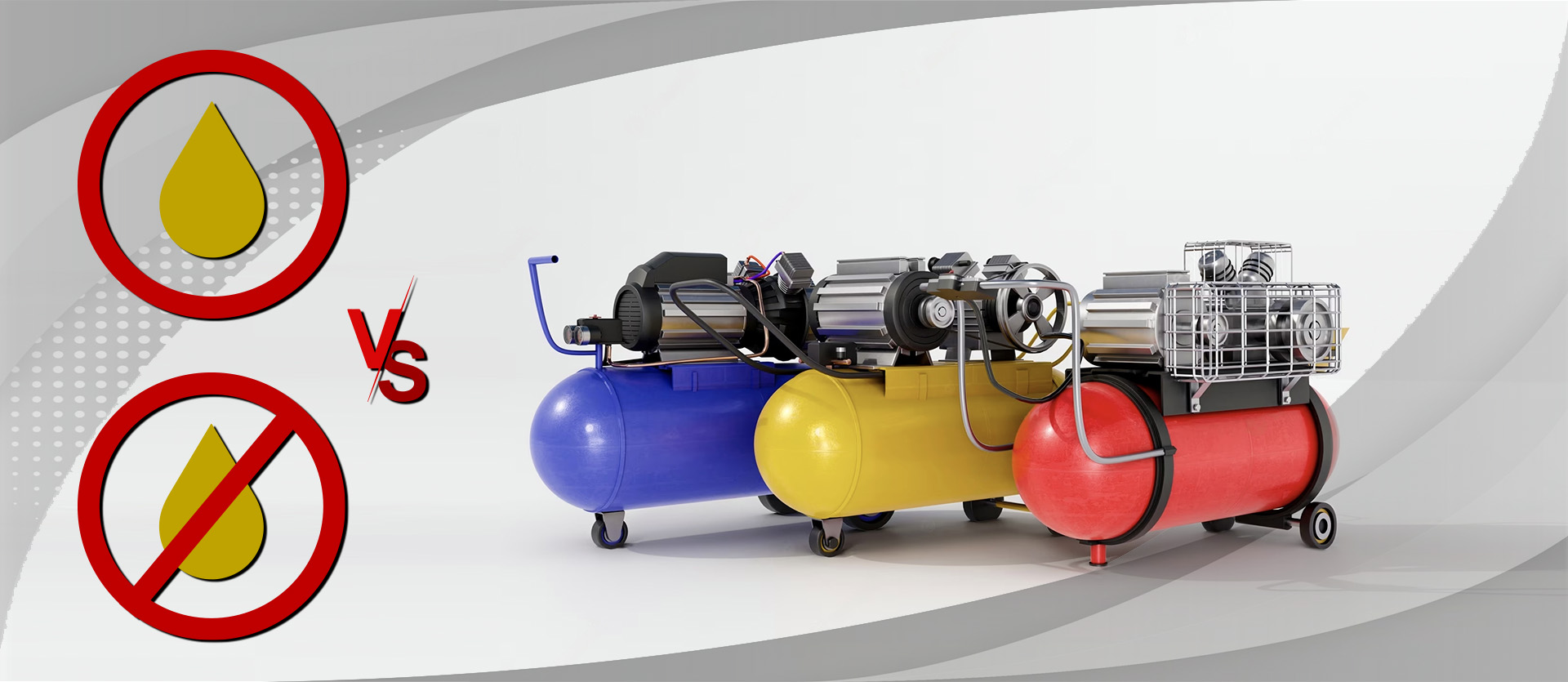Types of Compressors: Lubricated and Oil-Free Air Compressors
13 August 2023, Sunday

Compressed air compressors are widely popular among many businesses today. During the selection process, businesses face with 2 different options. One of these is lubricated air compressors and the other is oil-free air compressors. In this article, we will help people who cannot make a choice by explaining the difference between lubricated compressors and oil-free compressors.
What Are Oil-Free Compressors?

As their name suggests, oil-free air compressors are compressor models that do not contain oil and filters within the compressed air system. Oil-free air compressors are particularly used in sensitive industries such as healthcare and food industries. The biggest reason why they are frequently used in these industries is that the quality of the compressed air they provide is quite high. There are two different types of spiral-shaped impeller systems inside the oil-free air compressor. One of these spiral-shaped wheels is movable and the other is stationary. At the inlet port of oil-free air compressors, air is drawn in from the atmosphere. Then, motion occurs between the moving spiral wheel and the stationary spiral wheel. As a result of this motion, the compression ratio of the air inside increases continuously.
Oil-free air compressors are not completely oil-free. However, we can say that compressed air never comes into contact with oil in oil-free air compressors. Oil-free air compressors that utilize enclosed lubrication systems such as cylinders and intercoolers as the means of lubrication offer by far better air quality than other types of compressors.
What is the Operating Principle of Oil-Free Compressors?
Oil-free air compressors contain many main and auxiliary components. The compression of the air is carried out with the help of these components and the compressed air is supplied to the plant. Let's explain the operating principle of the oil-free air compressor by describing its components individually and explaining their functions.
To begin with, the most important part of the oil-free air compressor is obviously the spirals that perform the compression action. The air inside is compressed thanks to the logic of the geometry between the spirals. The spirals have a helical structure, that is, they are intertwined. The purpose of this is to increase the air pressure continuously. There are two helical spirals in oil-free air compressors. One of these is the moving spiral and the other is the stationary spiral. Both spirals are made of metal. One of the spirals is located on the top and the other on the bottom, so that both are connected to the spiral wheel. The moving spiral is placed on the top, but during the compression process it moves towards the spiral in the bottom. And the spiral at the bottom moves around its axis. Thanks to these spirals, the air entering the compressor moves in a certain plane and reaches the area between the disks. The disks compress the air coming from the plane by rotating around the centres to which they are attached. This compression process continues gradually as the disks rotate.
The spirals are not the only ones involved in the compression process. The spiral wheel set also ensures the rotation of these spirals. The compression process is performed with the spiral, which is the compression element, and the volume of the spiral wheel that is used for compression.
Another component of the oil-free compressors is the sealing element. This element prevents any air loss. Oil-free compressors are equipped with two sealing elements. One of these is the radial sealing element. The radial sealing element prevents air leakage through the gaps between the blades of the spiral. And the role of the axial sealing element is to prevent air leakage through the gaps between the blade tips and the base.
The air is gradually compressed by the compression chamber is subsequently transferred to the static vortex disk. The function of the static vortex disk here is to properly transfer the compressed air to the outlet. Since the air transferred by the static vortex disk is ready to be utilized, it is transferred directly to the outlet path and utilized there.
What Is a Lubricated Air Compressor?

As their name suggests, oil is actively circulated in the compressed air system of the lubricated air compressors. This oil has the function of preventing wear on the contact between the components of the machine, as well as better transmission of air.
In lubricated air compressors, the oil is supplied together with the compressed air. Air dryers in oil air compressors are included in the system to improve the quality of the compressed air. In other words, it should not be considered that oil is circulated with compressed air in lubricated air compressors and that there is oil in the air supplied to the outside. The filters present in the lubricated air compressors prevent the oil that is delivered with the compressed air from being transferred to the outside.
As we have just explained above, lubricated air compressors actively operate with oil. The system that is continuously supplied with oil has a longer service life and runs quieter. The operating principle of lubricated air compressors is similar to the operating principle of oil-free air compressors. The only difference here is the contact of compressed air and oil. Lubricated air compressors are frequently used in large volume industrial plants.
What are the Differences Between Lubricated Compressors and Oil-Free Compressors?
The differences between lubricated compressors and oil-free compressors can be listed as follows;
- - Let's explain the difference between lubricated compressors and oil-free compressors, starting with the air quality. In lubricated air compressors, the oil was supplied together with the compressed air. Even though filters and dryers play an active role and try to separate the air, the air quality is lower than the quality of air in oil-free compressors. If you have a business with very high hygiene requirements, for example if you are using a compressed air system in the food industry, you should prefer oil-free air compressors in this regard.
- - Another difference between lubricated air compressors and oil-free air compressors is the operating noise. The constant presence of oil in the system ensures a quieter operation of the system. Thus, lubricated air compressors are much quieter than oil-free air compressors.
- - Upkeep costs of lubricated air compressors are high as they require a lot of oil. However, oil-free air compressors have lower maintenance costs.
- - The service life of lubricated air compressors is slightly longer than that of oil-free air compressors. The reason for this is that there is oil constantly circulating in the system.
